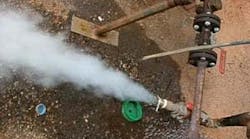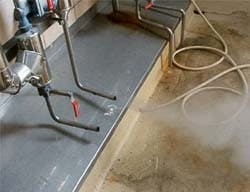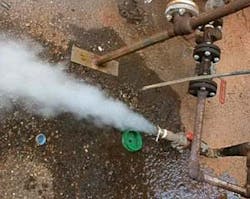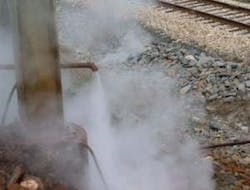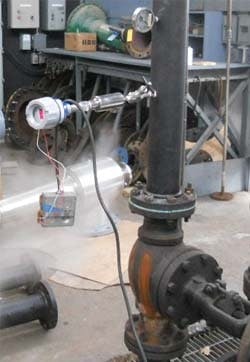Evaluating the pros and cons of measuring steam quality
Steam test methods
Eric Erpenbeck, P.E., mechanical engineering manager and head of central utilities group for Fosdick & Hilmer, recommends three different methods.
One is a visual test. This involves opening a steam valve from a steam trap station and blowing steam to the atmosphere. "Good steam quality should result in very little, if any, water exiting the pipe," says Erpenbeck. While there is no cost to this method, the downside is that it is not able to quantify the magnitude of the problem.
A second is a noncondensable gas kit. These involve multiple methods to test for noncondensable gases. "The industry offers portable steam quality test kits that utilize a condensor," says Erpenbeck. With the right test kit, the steam quality can be tested with repeatable results, therefore quantifying the magnitude of the problem.
A third is the dryness value test. This is intended to quantify the amount of moisture in the steam by using calorimetry, which calculates the amount of energy in a known amount of steam by condensing a sample in a known amount of water. "Increase in water temperature will determine the amount of energy in the steam, and therefore the amount of moisture," says Erpenbeck. "However, the calculation is difficult, because quantifying the amount of steam and water can be difficult, thus affecting the accuracy."
Source: Swagelok
What does Erpenbeck consider to be the best method? It depends on the application. "Visual inspections can be enough to know that steam quality is not meeting the design requirements and will need to be investigated at the steam generating source," he says. "With steam turbine-based electric generating stations, however, a noncondensable gas test or dryness value test may be required. In my opinion, the noncondensable gas test is the easiest method when it comes to quantifying steam quality."
Kelly Paffel, technical manager for Swagelok Energy Advisors, identifies some additional methods.
"One is called the Yarway method," he says. "However, it is very complex, requiring almost lab-type equipment."
A second involves installing a pressure-reducing station. "You can then install pressure and temperature instrumentation upstream of the station and downstream," says Paffel. "By knowing the degree of superheat that is generated across the pressure reduction, it gives you an indication of your steam quality."
High-quality steam reduces equipment, maintenance, and energy costs. Unfortunately, it’s not always easy to measure steam quality. There are a number of options, each with its pros and cons.
Poor steam quality
"Steam quality is the percent of steam that is vapor, meaning that steam quality of 99% is 99% vapor and 1% liquid," says Eric Erpenbeck, P.E., mechanical engineering manager and head of central utilities group for Fosdick & Hilmer, a consulting engineering company specializing in designing power stations for utilities, healthcare facilities, manufacturing facilities, educational facilities, and other industries. "The more liquid in the steam, the less heat can be transferred." Equipment requiring steam, such as heat exchangers and sterilizers, needs to have the correct heat transfer area to accommodate the specific steam quality anticipated. As steam quality degrades, either more steam is required to do the same heat transfer, resulting in poor heat transfer efficiency, or the steam equipment would need to be replaced with a larger heat transfer area to accommodate the wet steam. "In addition," says Erpenbeck, "poor steam quality can sometimes cause noise called 'water hammer' and potentially damage and cause premature failure in control valves and steam turbine applications. As such, good steam quality will keep the equipment appropriately sized, therefore saving capital dollars and minimizing maintenance issues."
Steam quality is very important, agrees Bruce Gorelick, manager, Energy Waste Services, for Ameresco, which develops energy management projects for customers in the commercial, industrial, and governmental sectors. "When you have saturated steam, there is still a degree of water in it,” he explains. “You want to minimize this water as much as possible, so that you have as much latent heat, or BTUs, to give off and be used in the steam process."
All heat transfer components, including shell/tube, plate/frame, plate/coil, and tracing, base performance calculations on 100% steam quality, unless the manufacturer is informed by the end user that the steam quality is lower than 100%, says Kelly Paffel, technical manager for Swagelok Energy Advisors, an engineering firm specializing in the evaluation of steam, condensate, and compressed air systems (Figure 1). "Unfortunately, steam quality is typically not monitored closely and is assumed to be 100% quality," he says. "Therefore, issues that arise from poor steam quality are blamed on some other item in the system." Low steam quality can lead to reduced heat transfer efficiency, premature valve failure, internal turbine component failures, and water hammer.
Figure 1. All heat transfer components base performance calculations on 100% steam quality, unless the manufacturer is informed by the end user that the steam quality is lower than 100%. Source: Swagelok
"The higher the steam quality, the less moisture, which means the higher the BTU content per pound, which means the more energy is available to do the job," says Andy Wales, western regional sales manager for Clayton Industries. "In addition, you don't want water in the header, because it causes damage to the header." That is, the dry portion of the steam has no chemicals in it. However, if you have moisture trapped in the steam, the moisture portion will contain some chemicals, which come over from the boiler and cause corrosive damage to the header.
|
A third, also mentioned by Erpenbeck, is a visual test. "This is one of the simplest ways to test, but it is a really crude way," says Paffel. "If you discharge saturated steam, which is a dry, invisible gas, into the atmosphere by opening a valve, you can see the entrainment into the steam vapor, which will let you know if your steam quality is good, bad or in-between." A fourth is to use specially-designed meters. Paffel is familiar with two companies that make these — Croll Reynolds and Panametrics, which is owned by General Electric. |
Assess steam quality
As Swagelok’s Paffel sees it, when it comes to steam quality, plant engineers should be asking themselves three questions (Figure 2).
Figure 2. Plant engineers should be asking themselves three questions. What is my steam quality today? Where should it be? How do I get there? Source: Swagelok
- What is my steam quality today?
- Where should it be?
- How do I get there?
"However, before you can deal with the third question, you need to deal with the second, and before you can deal with the second, you need to deal with the first," says Paffel. "And the first question begs another question: How can I measure and test my steam quality?"
What is considered good steam quality? "We are members of the Heat Exchange Institute, which recommends that steam have less than 2% moisture," says Philip Reynolds, P.E., vice president of Croll Reynolds. "High-quality steam provides better performance and prevents wear on the steam nozzles, so we always recommend a moisture separator and a trap before the steam reaches the injectors, to ensure good, dry steam.”
Measure steam quality
There are several ways to measure steam quality. Some are quick, easy, and inexpensive but often not particularly reliable. Others are more complicated and expensive but provide greater reliability.
"Steam quality is very difficult to measure," says Clayton Industries' Wales. "As far as I know, there is no reliable device that you can put on a steam line that will provide a continuous read on steam quality." The most common way with which Wales is familiar is to take a sample from the header and measure the conductivity of the sample once it has cooled. "This will give you the moisture content," he says. "However, again, if you want a continuous read, you would need to take continuous samples."
Steam quality measurement instruments
Source: Croll Reynolds
As a way to help customers ensure that high-quality steam enters its high-vacuum steam ejectors, Croll Reynolds developed a calorimeter to measure the moisture content and motive steam required to operate the high-vacuum ejector systems.
"A small portion of the steam to be sampled enters the calorimeter body through a sampling tube, which is installed directly in the steam header," says Philip Reynolds, P.E., vice president of Croll Reynolds. The steam sample passes through the sampling tube, is throttled through an orifice at constant enthalpy, and then passes into an expansion chamber. With the operator now knowing the header steam pressure and the temperature, he can refer to the moisture table provided with each unit and plot the moisture content. The sampled steam then passes through the calorimeter discharge port into the atmosphere.
"The calorimeter body can be installed on any size header," says Reynolds. "It is then connected to the sampling tube, and the globe valve is then turned to the open position." After the moisture reading has been taken, the calorimeter body can be disconnected from the sample tube and reinstalled on other headers.
For best performance, Reynolds says that the calorimeter should be installed in a vertical piece of pipe with the flow upward. "However, it can be used in horizontal pipe if necessary," he says.
General Electric offers the Panametrics Digital Flow XGS-868i steam flow ultrasonic transmitter, which is designed to measure the mass flow rate of saturated steam and superheated steam. "It doesn't measure steam quality directly, but it does ultrasonically measure temperature, pressure, and flow of the steam," says Randy Pfenninger, senior product manager, Gas Flow Products, for GE. "However, calculations can be made from these readings to determine steam quality." The measured flow velocity rate, along with the input of temperature and pressure, allow the onboard computer to calculate the steam mass flow rate. This flow rate can be displayed locally or transmitted to a remote system via an analog or digital communications link.
The Panametrics device provides constant, real-time measurements and can be installed on pipes anywhere from 2 in. in diameter all the way up to 24 in. in diameter.
